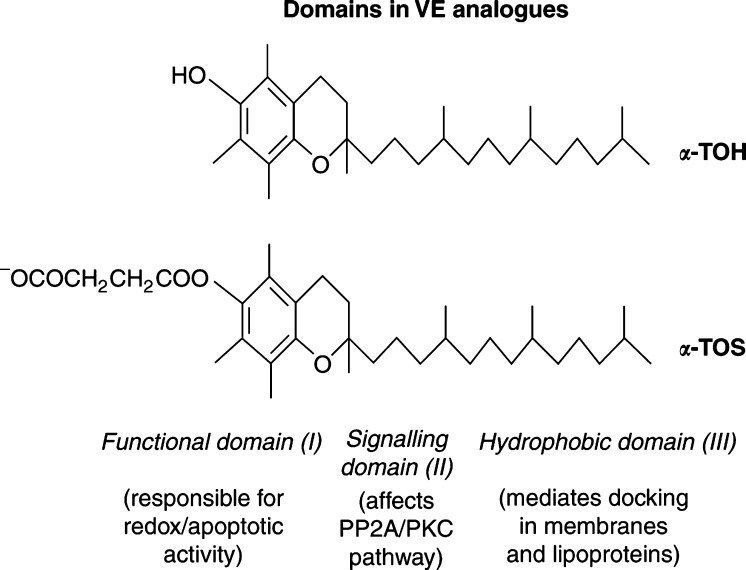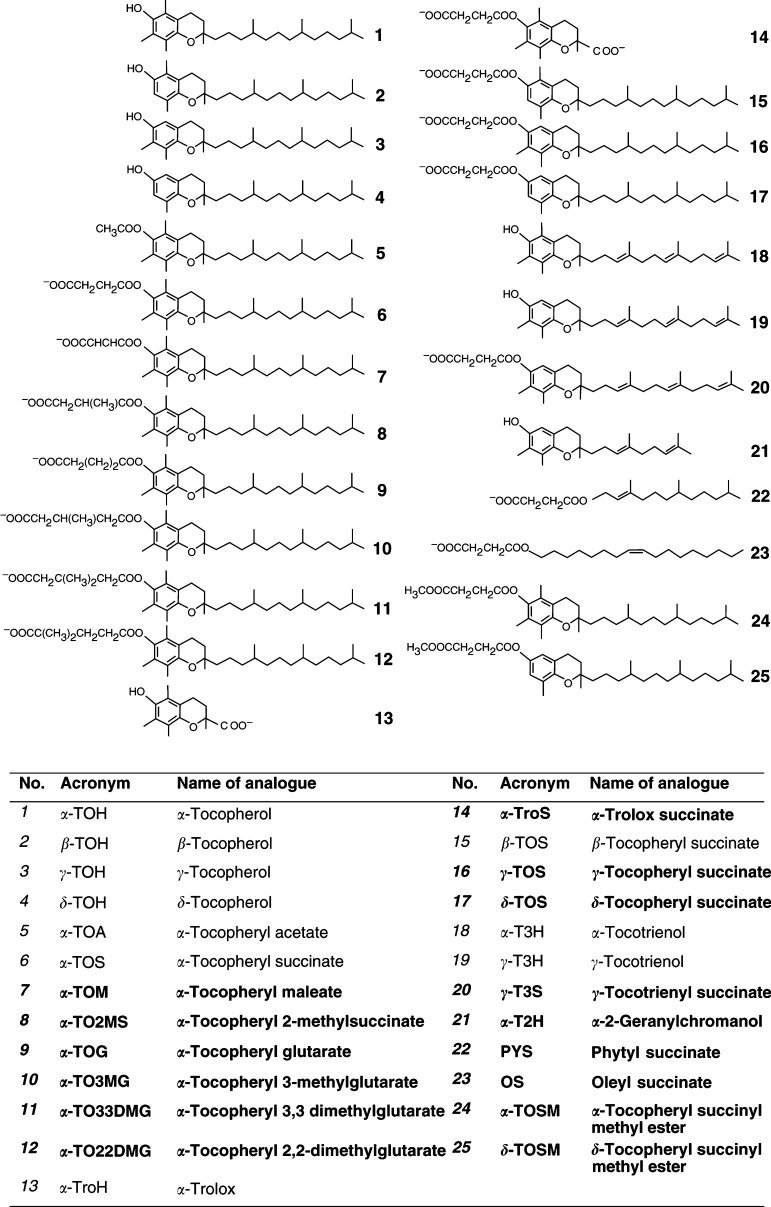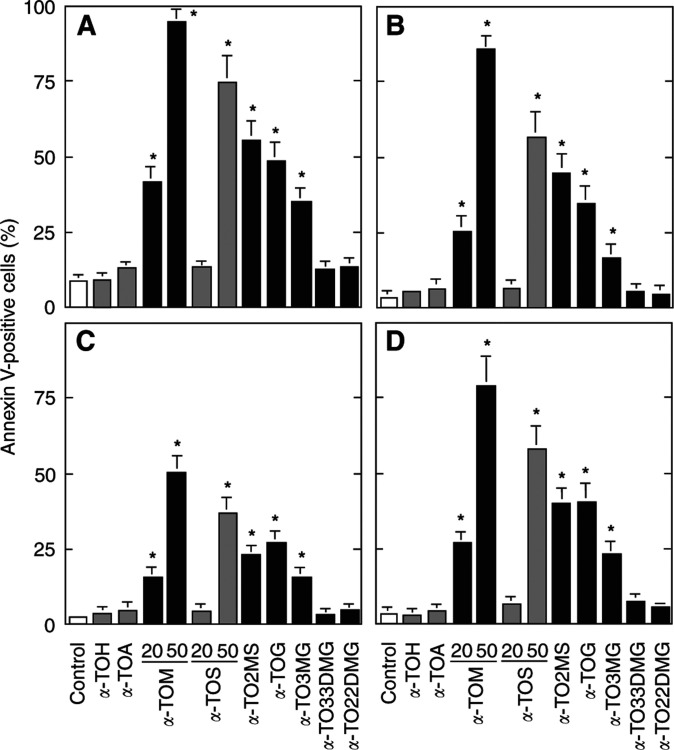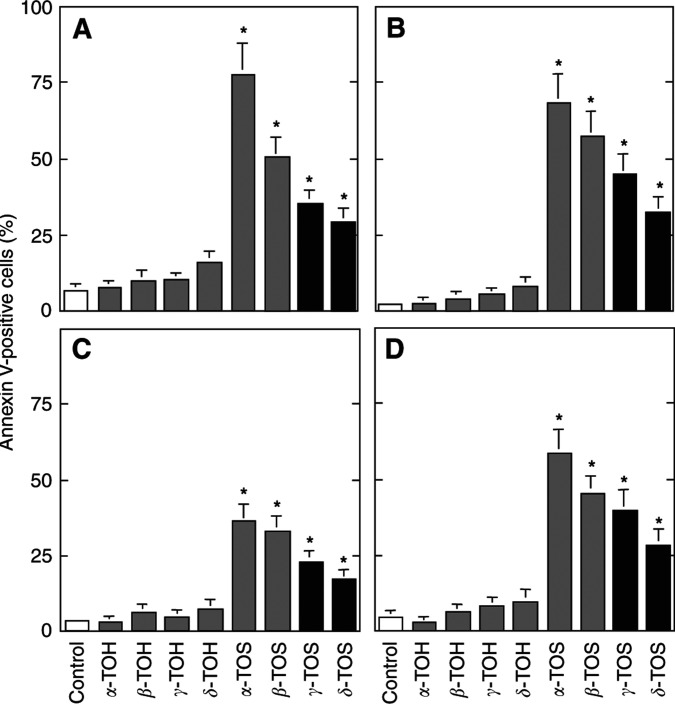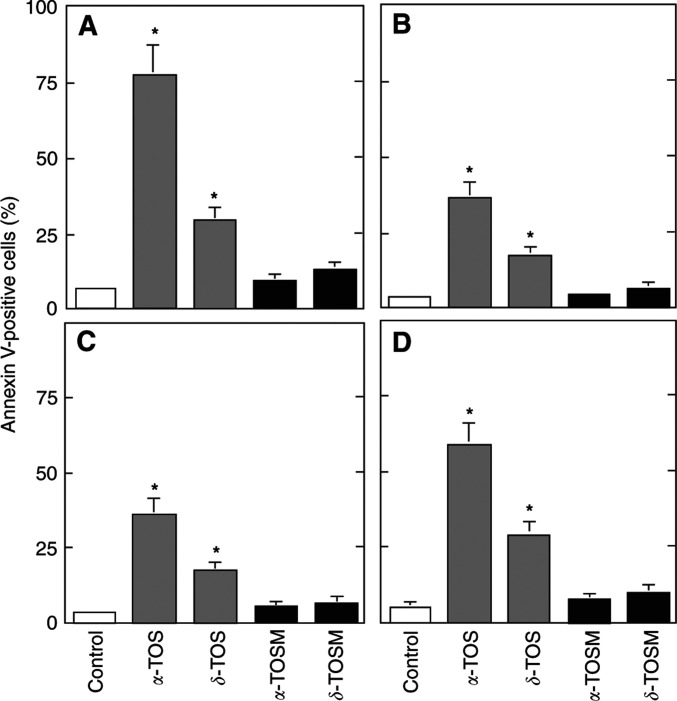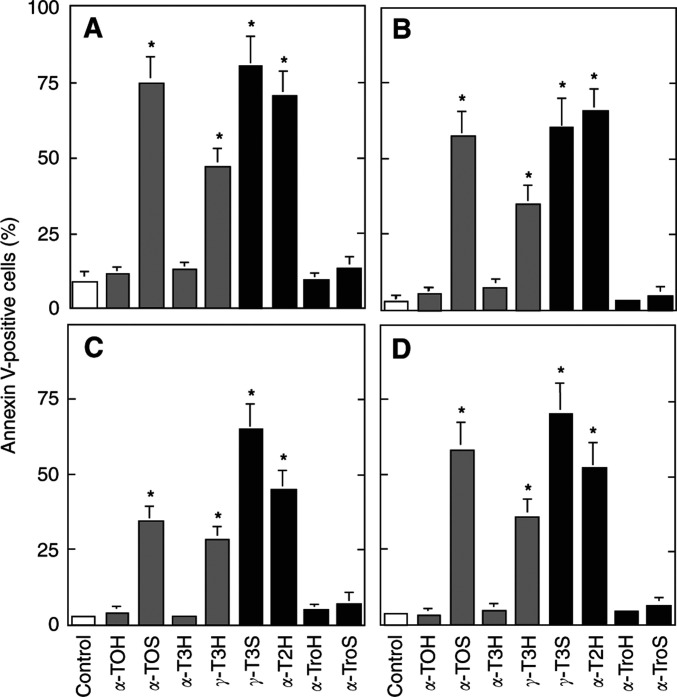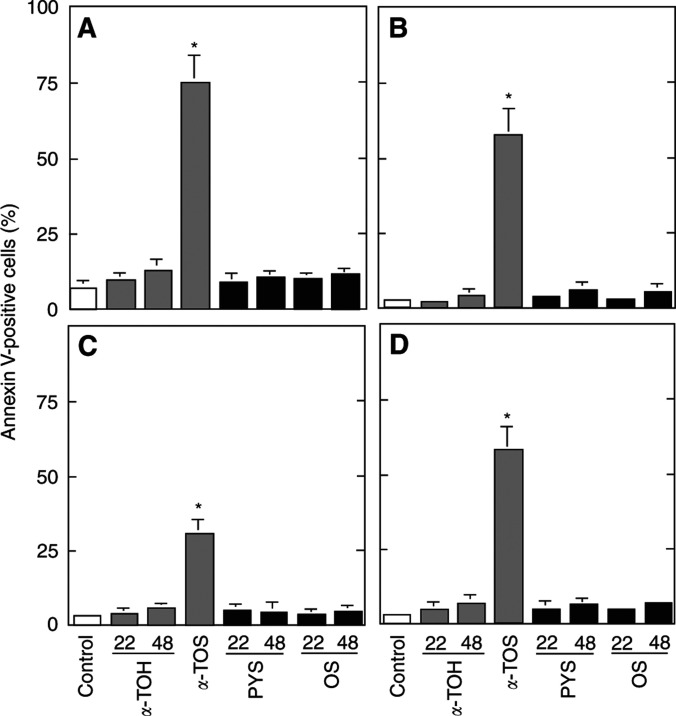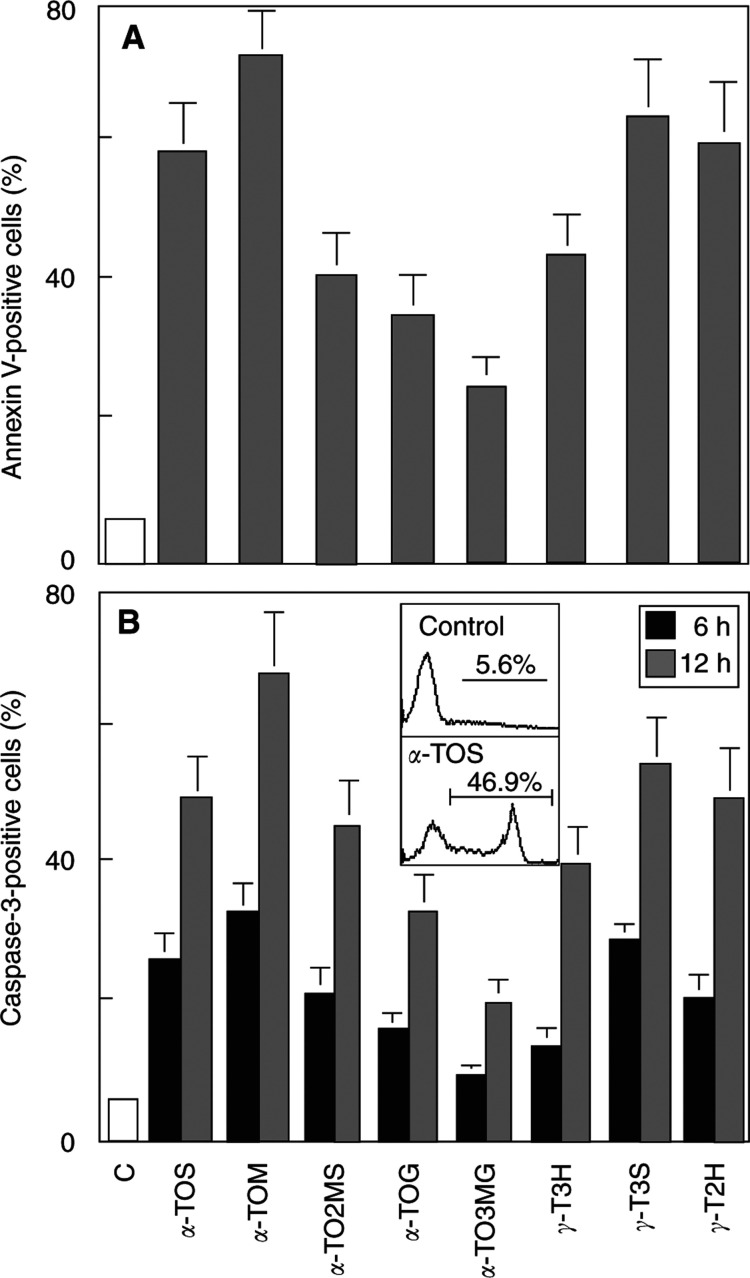Abstract
Recent results show that α-tocopheryl succinate (α-TOS) is a proapoptotic agent with antineoplastic activity. As modifications of the vitamin E (VE) molecule may affect its apoptogenic activity, we tested a number of newly synthesised VE analogues using malignant cell lines. Analogues of α-TOS with lower number of methyl substitutions on the aromatic ring were less active than α-TOS. Replacement of the succinyl group with a maleyl group greatly enhanced the activity, while it was lower for the glutaryl esters. Methylation of the free succinyl carboxyl group on α-TOS and δ-TOS completely prevented the apoptogenic activity of the parent compounds. Both Trolox and its succinylated derivative were inactive. α-tocotrienol (α-T3 H) failed to induce apoptosis, while γ-T3 H was apoptogenic, and more so when succinylated. Shortening the aliphatic side chain of γ-T3 by one isoprenyl unit increased its activity. Neither phytyl nor oleyl succinate caused apoptosis. These findings show that modifications of different functional moieties of the VE molecule can enhance apoptogenic activity. It is hoped that these observations will lead to the synthesis of analogues with even higher apoptogenic and, consequently, antineoplastic efficacy.
Keywords: vitamin E analogues, apoptosis, synthesis, anticancer effect
Current therapies for neoplastic disease, although often effective in causing remission, frequently lead to deleterious and even life-threatening side-effects. Therefore, there is great interest in developing otherwise nontoxic but effective antineoplastic agents, and inducers of apoptosis may fall into this category of agents (Ferreira et al, 2002). In this regard, recent findings suggest that certain analogues of vitamin E (VE), such as α-tocopheryl succinate (α-TOS), may represent a new class of antineoplastic agents with high selectivity for malignant cells and low toxicity. α-Tocopheryl succinate causes apoptotic death of a variety of neoplastic cell lines (Fariss et al, 1994; Qian et al, 1997; Neuzil et al, 1999; Yamamoto et al, 2000), whereas neither the redox-active α-tocopherol (α-TOH) nor its uncharged ester, α-tocopheryl acetate (α-TOA), is effective (Qian et al, 1997; Neuzil et al, 2001c). Therefore, the proapoptotic activity appears to be a unique feature of α-TOS, and this agent is also effective in vivo, inhibiting the growth of colon (Weber et al, 2002) and melanoma cancers (Malafa et al, 2001), promoting breast cancer dormancy (Malafa and Neitzel, 2000), and suppressing metastasis (Barnett et al, 2002). These intriguing observations have prompted us to investigate the molecular properties responsible for this interesting and evidently selective (Neuzil et al, 2001b) proapoptotic action of α-TOS.
The apparent selective toxicity of α-TOS towards malignant vs normal cells (Neuzil et al, 2001b, c; Weber et al, 2002) may be related to its negative charge at neutral pH, a notion supported by findings that its apoptotic action is enhanced at acidic pH (Neuzil et al, 2002b). The selective toxicity may thus arise from the fact that pH of the interstitium of most tumours is 6.2–6.5, but in the range of 7.0–7.4 for most normal tissues (Gerweck and Seetharam, 1996). Another possible mechanism by which VE analogues may exert selectivity is because of higher esterase activity of normal compared to malignant cells. Epithelial intestinal cells as well as hepatocytes are known to hydrolyse agents like α-TOS, while Jurkat T lymphoma cells are inefficient, whereby accumulating high levels of the toxic agent (Weber et al, 2003). The importance of the acidic environment is further supported by a recent observation that chlorambucil, a weak acid, exerted more profound antineoplastic effects when pH of the tumour interstitium was lowered (by hyperglycaemia) in an animal model of breast cancer (Kozin et al, 2001).
These findings suggest that modifications of individual functional moieties of VE analogues might modulate proapoptotic activity. We therefore synthesised novel analogues of VE differing from α-TOS in the ester side group, in the number and positions of methyl substitutions on the aromatic ring, and in the aliphatic side chain. We show here that these modifications change the original proapoptotic activity of α-TOS, either positively or negatively, depending on the type of modifications and their combination.
MATERIALS AND METHODS
Chemicals
α-D-tocopherol (α-TOH; 1), γ-D-tocopherol (γ-TOH; 3), α-D-tocopheryl acetate (α-TOA; 5), and α-D-tocopheryl succinate (α-TOS; 6) were from Sigma (Castle Hill, NSW, Australia), α-trolox (α-TroH; 13) was from Aldrich (Diesenhofen, Germany). β-D-tocopherol (β-TOH; 2), δ-D-tocopherol (δ-TOH; 4), α-tocotrienol (α-T3H; 18) and γ-tocotrienol (γ-T3H; 19) were kindly donated by Henkel Inc. (Stockholm, Sweden). Anhydrides of succinic acid, maleic acid, 2-methylsuccinic acid, glutaric acid, 3-methyl-glutaric acid, 3,3-dimethylglutaric acid, and 2,2-dimethylglutaric acid were purchased from Aldrich. Geranylaceton was purchased from Fluka (Diesenhofen, Germany). Methylene chloride was distilled over calcium hydride, under a nitrogen atmosphere. The diazomethane solution in ether was generated from Diazald, using a distillation apparatus with Clear-Seal glass joints (both items were purchased from Aldrich).
Synthesis
General remarks: Coupled HPLC-electrospray ionisation mass spectrometry (ESI-MS) was performed in negative ionisation. Trimethylsilylether was analysed by GC/MS with electrochemical ionisation. 1H NMR and 13C NMR spectra were recorded at 300 and 75.47 MHz, respectively, on Bruker AMX 300 with CDCl3 as solvent and TMS as internal standard. The carbon 13C values for the phytyl side chain of tocopherol derivatives (C1′ to C13′) are not listed, since they are only slightly affected by modifications of the chroman structure and are well established (Rosenau and Kosma, 2001).
General procedure for tocopheryl- and fatty alcohol carboxylate synthesis: Appropriate tocopherols/tocotrienols (4 mmol) or fatty alcohols (4 mmol) were dissolved in 15 ml of dry pyridine, and dicarboxylic acid anhydrides were added in a 50% molar excess. The solution was purged with argon and refluxed for 6–12 h depending on the substrates. The reaction mixture was poured into 100 ml of 1 M HCl and extracted three times with diethylether. The combined organic extracts were washed three times with 1 M HCl and dried with Na2SO4. After solvent evaporation, the crude product was purified by flash chromatography (4 : 2 hexane : ethyl acetate). The yields ranged between 30 and 75%.
General procedure for methyl ester formation of tocopheryl carboxylates. The tocopheryl carboxylate (0.16 mmol) and dichloromethane (1 ml) were added to a scratch-free 25 ml Erlenmeyer flask. An ice-cold solution of diazomethane in ether (0.7 ml, 0.3 M) was added drop-wise to the flask with stirring. Nitrogen gas evolved for several minutes, and the solution maintained a yellow colour. The progress of the reaction was monitored by thin layer chromatography; it was generally complete within 5 min. Upon completion, a dilute solution of acetic acid in methanol was added drop-wise, until the yellow colour disappeared and it became colourless. The solvent was removed by rotary evaporation, followed by placement under high vacuum (0.1 Torr). This reaction generally provides quantitative yields of the desired methyl ester (pure by TLC). Flash column chromatography of the product is optional. This can be performed in hexane/ethyl acetate (10 : 1) to provide a sample for analytical characterisation.
RRR-α-tocopheryl maleate (α-TOM; 7).
Brown semisolid; 1H NMR (CDCl3) δ 0.84 (d, 3 H), 0.86 (d, J=6.6 Hz, 6 H), 0.87 (d, 3 H), 1.25 (s, 3 H), 1.1–1.5 (m, 19 H), 1.5–1.6 (m, 2 H), 1.79 (m, 2 H), 1.98 (s, 3 H), 2.02 (s, 3 H), 2.10 (s, 3 H), 2.60 (t, J=6.9 Hz, 2 H), 7.14 (AB, J=15.6 Hz, 2 H); 13C NMR (CDCl3) δ 11.8, 12.1, 13.0, 20.6, 24.4, 30.9, 75.2, 117.6, 123.3, 123.9, 126.4, 2 × 135.0, 140.0, 149.8, 2 × 169.2; ESI-MS (m/z): 527 (MH+).
RRR-α-tocopheryl 2-methylsuccinate (α-TO2MS; 8).
Yellow semisolid; 1H NMR (CDCl3) δ 0.84 (d, J=6.6 Hz, 3 H), 0.86 (d, J=6.6 Hz, 6 H), 0.87 (d, J=6.4 Hz, 3 H), 1.23 (s, 3 H), 1.1–1.5 (m, 19 H), 1.46 (d, J=7.2 Hz, 3 H), 1.5–1.6 (m, 2 H), 1.77 (m, 2 H), 1.96 (s, 3 H), 2.00 (s, 3 H), 2.08 (s, 3 H), 2.60 (t, J=6.9 Hz, 2 H), 2.6–2.8 (m, 1 H), 2.9–3.1 (m, 2 H); 13C NMR (CDCl3) δ 11.8, 12.0, 12.9, 17.0, 20.6, 24.4, 31.1, 35.6, 37.0, 75.0, 117.3, 123.2, 124.9, 126.5, 140.4, 149.4, 173.6, 177.7; ESI-MS (m/z): 543 (MH+).
RRR-α-tocopheryl glutarate (α-TOG; 9).
Yellow semisolid; 1H NMR (CDCl3) δ 0.84 (d, J=6.6 Hz, 3 H), 0.86 (d, J=6.6 Hz, 6 H), 0.87 (d, J=6.4 Hz, 3 H), 1.23 (s, 3 H), 1.1–1.5 (m, 19 H), 1.5–1.6 (m, 2 H), 1.7–1.9 (m, 2 H), 1.96 (s, 3 H), 2.00 (s, 3 H), 2.09 (s, 3 H), 2.1–2.2 (m, 2 H), 2.54 (t, J=7.2 Hz, 2 H), 2.57 (t, J=5.1 Hz, 2 H), 2.70 (t, J=7.5 Hz, 2 H); 13C NMR (CDCl3) δ 11.8, 12.1, 13.0, 20.2, 20.6, 24.4, 31.1, 32.9, 33.0, 75.2, 117.4, 122.9, 125.1, 126.6, 140.4, 149.4, 171.4; ESI-MS (m/z): 543 (MH+).
RRR-α-tocopheryl 3-methylglutarate (α-TO3MG; 10).
Yellow semisolid; 1H NMR (CDCl3) δ 0.84 (d, J=6.6 Hz, 3 H), 0.86 (d, J=6.6 Hz, 6 H), 0.87 (d, J=6.4 Hz, 3 H), 1.23 (s, 3 H), 1.1–1.5 (m, 20 H), 1.17 (d, J=6.0 Hz, 3 H), 1.5–1.6 (m, 2 H), 1.7–1.9 (m, 2 H), 1.97 (s, 3 H), 2.01 (s, 3 H), 2.08 (s, 3 H), 2.4 (m, 2 H), 2.58 (t, J=7.2 Hz, 2 H), 2.7 (m, 2 H); 13C NMR (CDCl3) δ 11.8, 12.2, 13.0, 19.9, 20.6, 24.4, 27.1, 31.1, 40.2, 40.4, 75.0, 117.4, 123.0, 124.7, 126.6, 140.5, 149.4, 170.8, 178.0; ESI-MS (m/z): 557 (MH+).
RRR-α-tocopheryl 3,3-dimethylglutarate (α-TO33DMG; 11)
Yellow semisolid; 1H NMR (CDCl3) δ 0.84 (d, J=6.6 Hz, 3 H), 0.86 (d, J=6.6 Hz, 6 H), 0.87 (d, J=6.4 Hz, 3 H), 1.23 (s, 3 H), 1.1–1.5 (m, 19 H), 1.25 (s, 6 H), 1.5–1.6 (m, 2 H), 1.7–1.9 (m, 2 H), 1.97 (s, 3 H), 2.01 (s, 3 H), 2.08 (s, 3 H), 2.58 (m, 2 H), 2.62 (s, 2 H), 2.79 (s, 2 H); 13C NMR (CDCl3) δ 11.8, 12.3, 13.1, 20.6, 24.4, 28.0, 31.1, 2 × 32.4, 43.9, 44.5, 75.0, 117.3, 123.0, 124.9, 126.7, 140.5, 149.4, 170.8, 177.2; ESI-MS (m/z): 571 (MH+).
RRR-α-tocopheryl 2,2-dimethylglutarate (α-TO22DMG; 12)
Yellow semisolid; 1H NMR (CDCl3) δ 0.84 (d, J=6.6 Hz, 3 H), 0.86 (d, J=6.6 Hz, 6 H), 0.87 (d, J=6.4 Hz, 3 H), 1.23 (s, 3 H), 1.1–1.5 (m, 19 H), 1.30 (s, 6 H), 1.5–1.6 (m, 2 H), 1.7–1.9 (m, 2 H), 1.96 (s, 3 H), 2.00 (s, 3 H), 2.08 (s, 3 H), 2.1 (m, 2 H), 2.58 (t, J=6.6 Hz, 2 H), 2.65 (m, 2 H); 13C NMR (CDCl3) δ 11.8, 12.1, 13.0, 20.6, 24.4, 24.8, 24.9, 30.0, 31.1, 35.0, 41.6, 75.0, 117.4, 123.0, 124.9, 126.6, 140.4, 149.4, 171.9, 183.1; ESI-MS (m/z): 571 (MH+).
Trolox succinate (TroS; 14)
Brown solid; 1H NMR (CDCl3) δ 1.64 (s, 3 H), 1.91 (s, 3 H), 2.00 (s, 3 H), 2.15 (s, 3 H), 2.4 (m, 2 H), 2.6 (m, 2 H), 2.76–3.1 (m, 4 H); 13C NMR (CDCl3), δ 11.3, 12.0, 12.9, 20.5, 25.1, 28.7, 28.9, 31.1, 76.2, 117.2, 123.1, 124.2, 125.4, 140.8, 145.1, 170.3, 172.6, 174.8; ESI-MS (m/z): 349 (MH+).
RRR-δ-tocopheryl succinate (δ-TOS; 17)
Yellow semisolid; 1H NMR (CDCl3) δ 0.84 (d, J=6.6 Hz, 3 H), 0.86 (d, J=6.6 Hz, 6 H), 0.87 (d, J=6.4 Hz, 3 H), 1.23 (s, 3 H), 1.1–1.5 (m, 19 H), 1.5–1.6 (m, 2 H), 1.77 (m, 2 H), 2.14 (s, 3 H), 2.60 (t, J=6.9 Hz, 2 H), 2.80–2.84 (m, 4 H), 6.6–6.7 (m, 2 H); 13C NMR (CDCl3) δ 16.1, 19.6, 19.7, 30.0, 22.4, 22.6, 22.7, 24.4, 24.8, 28.0, 28.9, 28.9, 31.0, 32.7, 32.8, 37.2, 37.4, 40.2, 75.0, 118.9, 2 × 121, 127.3, 142.3, 149.8, 171.3, 177.8; ESI-MS (m/z): 501 (MH+).
R-γ-tocotrienyl succinate (γ-T3S; 20)
Yellow semisolid; 1H NMR (CDCl3) δ 1.26 (s, 3 H), 1.60 (s, 9 H), 1.68 (s, 3 H), 1.5–1.9 (m, 2 H), 1.95–2.2 (m, 12 H), 2.01 (s, 3 H), 2.10 (s, 3 H), 2.71 (m, 2 H), 2.75–2.95 (m, 4 H), 5.11 (m, 3 H), 6.57 (s, 1 H); 13C NMR (CDCl3) δ 11.9, 12.6, 15.9, 16.0, 17.6, 22.2, 2 × 24.1, 25.7, 26.6, 26.8, 28.9, 28.9, 31.0, 2 × 39.7, 40.0, 75.0, 113.3, 118.4, 118.8, 124.2, 124.4, 125.9, 127.1, 131.2, 135.0, 135.2, 141.5, 149.46, 170.5, 171.2; ESI-MS (m/z): 509 (MH+).
Phytyl succinate (PYS; 22)
Colourless semisolid; 1H NMR (CDCl3) δ 0.84 (d, J=6.6 Hz, 3 H), 0.86 (d, J=6.6 Hz, 6 H), 0.87 (d, J=6.4 Hz, 3 H), 1.1–1.5 (m, 19 H), 1.70 (s, 3 H), 1.95–2.15 (m, 2 H), 2.6 (m, 4 H), 4.62 (t, J=6.9 Hz, 2 H), 5.34 (m, 1 H); 13C NMR (CDCl3) δ 16.3, 2 × 19.7, 2 × 22.7, 24.5, 24.8, 28.0, 28.9, 29.0, 32.6, 32.7, 32.7, 32.8, 36.6, 36.8, 37.3, 37.4, 39.3, 61.8, 117.8, 143.1, 172.3, 178.1; ESI-MS (m/z): 395 (MH+).
Oleyl succinate (OS; 23).
Colourless semisolid; 1H NMR (CDCl3) δ 0.88 (t, 3 H), 1.2–1.4 (m, 22 H), 1.62 (m, 2 H), 2.01 (m, 4 H), 2.66 (m, 4 H), 4.09 (t, J=6.6 Hz, 2 H), 5.35 (m, 2 H); 13C NMR (CDCl3) δ 14.1, 22.7, 25.8, 2 × 27.2, 28.5,2 × 28.9, 2 × 29.2, 2 × 29.3, 29.4, 29.5, 29.7, 29.8, 31.9, 65.0, 129.8, 130.0, 172.2, 178.1; ESI-MS (m/z): 367 (MH+).
RRR-α-tocopheryl succinyl methyl ester (α-TOSM; 24).
Clear colourless oil; 1H NMR (CDCl3) δ 0.85 (d, J=6.6 Hz, 3 H), 0.86 (d, J=6.3 Hz, 3 H), 0.87 (d, J=6.6 Hz, 6 H), 1.24 (s, 3 H), 1.02–1.44, (m, 19 H), 1.46–1.60 (m, 2 H) , 1.74–1.82 (m, 2 H), 1.98 (s, 3 H), 2.02 (s, 3 H), 2.09 (s, 3 H), 2.59 (t, J=6.7 Hz, 2 H), 2.77 (m, 2 H), 2.94 (m, 2 H), 3.72 (s, 3 H); 13C NMR (CDCl3) 11.8, 12.0, 12.9, 19.6, 19.7, 20.6, 21.0, 22.6, 22.7, 24.4, 24.8, 28.0, 28.8, 28.9, 31.1, 32.7, 32.8, 37.3, 37.4, 39.3, 51.9, 75.0, 77.2, 117.3, 123.0, 124.9, 126.6, 140.4, 149.4, 170.9, 172.6.
RRR-δ-tocopheryl succinyl methyl ester (δ-TOSM; 25).
Clear colourless oil; 1H NMR (CDCl3) δ 0.77 (d, J=7.1 Hz, 3 H), 0.78 (d, J=6.6 Hz, 3 H), 0.80 (d, J=6.6 Hz, 6 H), 1.18 (s, 3 H), 0.94–1.39, (m, 19 H), 1.41−1.51 (m, 2 H), 1.62–1.75 (m, 2 H), 2.06 (s, 3 H), 2.63–2.68 (m, 4 H), 2.75-2.80 (m, 2 H), 3.65 (s, 3 H), 6.55 (d, J=2.5 Hz, 1 H), 6.60 (d, J=2.5 Hz, 1 H); 13C NMR (CDCl3) δ 16.1, 19.6, 19.7, 21.0, 22.4, 22.6, 22.7, 24.2, 24.4, 24.8, 28.0, 29.0, 29.3, 30.9, 32.7, 32.8, 37.3 37.41, 37.43, 39.4, 40.1, 51.9, 76.1, 77.2, 118.9, 120.9, 121.0, 127.3, 142.3, 149.8, 171.6, 172.6.
Synthesis of α-2-geranylchromanol. 2, 6, 10-trimethyl-10-hydroxy-2, 6, 11-dodecatriene
Vinyl magnesium bromide (1 M in tetrahydrofuran, 6.4 ml, 6.4 mmol) was added with vigorous stirring under argon at 0–5°C to a solution of geranylaceton (1.2 g, 6.2 mmol) in diethylether (100 ml) over 60 min. The reaction mixture was stirred for additional 30 min and acidified with 1 M HCl to pH 2, and diluted with water to dissolve precipitated salts. This solution was extracted with ether (3 × 100 ml), and the combined ether extracts washed with brine (3 × 50 ml) and dried over Na2SO4. Ether was removed on a rotavapor to yield yellow oil that was used without further purification.
α-2-geranylchromanol (α-T2H; 21)
Vinyl alcohol (0.96 g, 4 mmol) in dioxane (2 ml) was added over 1.5 h at 110°C to a stirred solution of 2,3,5-trimethylhydroquinone (0.42 g, 2.8 mmol) and boron trifluoride etherate (0.7 ml, 5.5 mmol) in dioxane (15 ml) under argon. The reaction mixture was extracted with ethyl acetate (3 × 100 ml). The combined organic layers were washed with water, dried over Na2SO4, concentrated under vacuum and applied to a silica gel chromatography (hexane : ethyl acetate, 5 : 1) to yield orange oil (285 mg, 30%). 1H NMR (CDCl3) δ 1.16 (s, 3 H), 1.60 (s, 6 H), 2.34 (s, 3 H), 1.95–2.2 (m, 6 H), 1.98 (s, 3 H), 2.01 (s, 3 H), 2.10 (s, 3 H), 2.69 (m, 2 H), 5.05 (m, 3 H); 13C-NMR (CDCl3) δ 11.8, 11.9, 12.0, 17.8, 22.2, 2 × 24.1, 24.2, 25.7, 26.8, 31.0, 39.6, 40.3, 75.1, 118.4, 118.8, 124.4, 124.9, 125.9, 126.9, 131.0, 135.1, 145.2, 149.5; MS (EI) m/z of trimethylsilylether: 428 (M+).
Cell culture and treatment
The human T lymphoma cell line Jurkat, neuroblastoma cell line HTB11, and the breast carcinoma cell line MCF7 and its caspase-3-expressing variant (Mathiasen et al, 1999) were used in the study. Jurkat cells were maintained in the RPMI-1640 medium supplemented with 10% foetal calf serum (FCS) and antibiotics, while the other lines were cultured in DMEM with 10% FCS and antibiotics. Suspension cells (0.5 × 106 ml−1) and adherent cells (50–70% confluency) were exposed to individual agents at their concentration of up to 50 μM for varying periods of time and assessed for apoptosis as detailed below.
Apoptosis evaluation
Apoptosis was routinely assessed by the annexin V-binding method, which is based on affinity of annexin V to phosphatidylserine externalised to the outer leaflet of the plasma membrane early in the course of apoptosis (Neuzil et al, 2001a). In brief, suspension cells were harvested by spinning down, while adherent cells were detached by treatment with 2 mM EDTA in PBS and combined with the cells detached during treatment. The cells were then washed with PBS, spun down, resuspended in the binding buffer (10 mM Hepes/NaOH, 140 mM NaCl and 25 mM CaCl2, pH 7.4), incubated with 2 μl of annexin V–FITC (PharMingen, San Diego, CA, USA), and analysed by flow cytometry (Becton Dickinson, Rutherford, NJ, USA). In some cases, activation of caspase-3 was assessed as follows. Treated cells were washed, permeabilised with 0.02% saponin in PBS, and incubated with an antibody raised against activated caspase-3 (PharMingen) at room temperature for 60 min. The cells were then washed and incubated with secondary IgG conjugated to FITC at room temperature for additional 60 min, washed, and scored for FITC binding in a flow cytometer. The percentage of apoptotic cells or cells with activated caspase-3 was estimated by gating on the population with high fluorescence.
Unless specified otherwise, the data shown are mean values ±s.d. (n=3). The asterisk at individual values indicates statistically significant difference from the control with P<0.05, as determined by the Student's t-test.
RESULTS AND DISCUSSION
The molecule of VE can be divided into three functionally distinct domains (Figure 1) (Neuzil et al, 2002a). Domain I (the functional domain) is essential for the redox activity of VE analogues, which involves the hydroxyl group in position C6 of the chromanol ring structure. Interestingly, α-TOH does not induce apoptosis (Qian et al, 1997; Neuzil et al, 2001c), nor does it when acetylated at C6 (α-TOA) (Neuzil et al, 2001a). However, succinylation in this position makes α-TOH a strong apoptogen (Neuzil et al, 2001c). Conversion of α-TOH into a charged species may thus play a role in apoptosis induction (Neuzil et al, 2002b). We therefore investigated the effects of substituting α-TOS with other dicarboxylic acids in this position. Of these analogues, α-TOM was more apoptogenic compared to α-TOS, whereas the other esters tested were less effective than α-TOS in the order α-TO2MS >α-TOG >α-TO3MG >α-TO33DMG=α-TO22DMG (Figures 2 and 3).
Figure 1.
Functional domains in the molecule of VE. Vitamin E analogues (represented here by α-TOH and α-TOS) comprise three distinct domains, each responsible for a separate ‘function’ of the agent. Domain I, the functional domain, decides whether the compound is redox-active or redox-inactive. Domains II, the signalling domain, is responsible for effects of the analogues such as deregulation of the protein kinase C/protein phosphatase 2A pathway. Domain III, the hydrophobic domain, is responsible for docking of VE analogues in biological membranes and lipoproteins.
Figure 2.
Analogues of VE used in this study. The items shown in bold indicate newly synthesised compounds.
Figure 3.
Effect of modifications in domain I of the VE molecule on their apoptogenic activity. Jurkat (A), HBT11 (B), MCF7 (C), and MCF7-C3 cells (D) were exposed for 24 h to α-TOH, α-TOA, α-TOM, α-TOS, α-TO2MS, α-TOG, α-TO3MG, α-TO33DMG, or α-TO22DMG (11), and assessed for apoptosis using the annexin V–FITC method.
Naturally occurring derivatives of α-TOH differ in the number and position of methyl substitutions on the aromatic ring, that is domain II (signalling domain). These include β-, γ- and δ-TOH. All of these agents were largely nonapoptogenic (Neuzil et al, 2002a) (Figure 4). Succinylation made them proapoptotic, although the activity of β-, γ- and δ-TOS was lower than that of α-TOS, with δ-TOS being least apoptogenic (Figure 4). Their efficacy in inhibiting protein kinase C also differs, and is not dependent on their antioxidant capacity (Ricciarelli et al, 2001). In addition, the substitution pattern is responsible for the rate of side chain degradation, as γ- and δ-TOH are degraded much faster than α- or β-TOH in cell culture (Birringer et al, 2001).
Figure 4.
Effect of modifications in domain II of the VE molecule on their apoptogenic activity. Jurkat (A), HBT11 (B), MCF7 (C) and MCF7-C3 cells (D) were exposed for 24 h to α-TOH, β-TOH, γ-TOH, δ-TOH, α-TOS, β-TOS, γ-TOS, or δ-TOS, and assessed for apoptosis using the annexin V–FITC method.
To address the importance of the free carboxylic group for apoptogenic activity of VE dicarboxylic acid esters with saturated isoprenyl side chains, we esterified α-TOS and δ-TOS on the succinyl moiety. The resulting methyl esters were completely inactive as inducers of apoptosis in all cell lines tested (Figure 5).
Figure 5.
Effect of methylation of the succinyl moiety of VE succinyl analogues on their apoptogenic activity. Jurkat (A), HBT11 (B), MCF7 (C) and MCF7-C3 cells (D) were exposed for 24 h to α-TOS, δ-TOS, α-TOSM or δ-TOSM, and assessed for apoptosis using the annexin V–FITC method.
Several modifications of the aliphatic side chain (domain III, the hydrophobic domain) are possible. Its desaturation, in the case of α-TOH, gives the naturally occurring α-T3H, which is nonapoptotic (Yu et al, 1999). γ-T3H, however, has a strong apoptogenic activity (Yu et al, 1999), which is further enhanced by its conversion to γ-T3S (Figure 6). Interestingly, a derivative of γ-T3H with the aliphatic side chain shorter by one isoprenyl unit, α-T2H, exerted higher proapoptotic activity than did γ-T3H itself (Figure 6). Analogues of VE lacking the aliphatic side chain, that is, α-TroH and α-TroS did not induce apoptosis, regardless of the succinylation status (Figure 6).
Figure 6.
Effect of modifications in domain III of the VE molecule on their apoptogenic activity. Jurkat (A), HBT11 (B), MCF7 (C) and MCF7-C3 cells (D) were exposed for 24 h to α-TOH, α-TOS, α-T3H, γ-T3H, γ-T3S, α-T2H, α-TroH, or α-TroS, and assessed for apoptosis using the annexin V–FITC method.
Finally, we synthesised succinyl esters of long-chain fatty acids, that is, PYS and OS. Neither of them caused any signs of apoptosis at up to 100 μM and at times of up to 48 h (Figure 7). These results indicate that presence of an aliphatic group at one end and a chargeable moiety at the other end is not sufficient for apoptosis induction and that presence of the chromanol structure may be essential.
Figure 7.
Proapoptotic activity of other structural analogues of VE. Jurkat (A), HBT11 (B), MCF7 (C), and MCF7-C3 cells (D) were exposed for 24 h to α-TOS, and for 22 or 48 h to α-TOH, PYS, or OS, and assessed for apoptosis using the annexin V–FITC method.
Toxicity of α-TOS towards cancer cells is known to be governed by apoptotic signalling. To find out whether this form of cell death is also involved in killing by the newly synthesised VE analogues, we exposed Jurkat cells to the agents for increasing time, and analysed the cells for caspase-3 activation, a hallmark of apoptotic signalling. As demonstrated in Figure 8, all new VE analogues, which were shown above to cause annexin V binding in several cancer cell lines, caused time-dependent activation of caspase-3. Assessment of annexin V binding was carried out on adherent and detached cells pooled together (see Materials and Methods section). It cannot be excluded that some of the cells died by anoikis. However, similar effects wre observed with suspension, Jurkat cells. This strongly suggests that apoptotic cell death is the major mechanism by which these novel agents kill cancer cells.
Figure 8.
Vitamin E analogues induce apoptosis and activate caspase-3. Jurkat cells were exposed for the time shown to 50 μM each of α-TOS, α-TOM, α-TO2MS, α-TOG, α-TO3MG, γ-T3H, γ-T3S, or γ-T2H, and assessed for apoptosis extent (A) and caspase-3 activation using the antibody specific for activated caspase-3 and a secondary, FITC-conjugated antibody (B). The inset in (B) shows a typical histogram of flow cytometric evaluation of control cell and cells treated with 50 μM α-TOS for 12 h.
The data presented herein suggest the following conclusions: (i) Forms of VE with saturated aliphatic chains need to be esterified with a dicarboxylic acid to exert apoptogenic activity. (ii) The extent of proapoptotic effect is greatly dependent on the un-saturation and length of the ester group substituent. Thus, the C6 maleyl-substituted analogue showed the highest activity, which was virtually nondetectable in case of the 2,2-dimethyl- and 3,3-dimethylglutaryl substituents. This may suggest that the apparently less water-soluble agents are less bioavailable for the malignant cells tested. Moreover, α-TOM may have higher in vivo effectiveness as it is ∼10–20-fold more efficient in vitro than the relatively well-studied α-TOS. The latter agent exerts antitumour effects against experimental colon cancer at the pharmacologically relevant blood levels of ∼40–50 μM (Weber et al, 2002). We would thus expect α-TOM to be equipotent with α-TOS in vivo at its plasma levels of ∼5 μM, that is, similar to those of circulating VE. (iii) Finally, and perhaps most importantly, the apoptogenic activity of α-TOS and related derivatives does require a chargeable substituent in position C6. This conclusion is supported by the fact that α-TOS and α-TOA, while taken up at comparable rates (Cheeseman et al, 1998), show a completely different apoptogenic potential (cf Figure 3), and, in particular, by the finding that esterification of the free carboxyl group on the succinyl moiety completely obliterates apoptogenic activity of the parent compounds (cf Figure 5).
One possible mechanism underlying the proapoptotic effects of α-TOS and similar compounds may involve membrane destabilisation. α-Tocopheryl succinate has an aliphatic side chain, which docks it in the lipid phase (Pussinen et al, 2000), and a hydrophilic head group. In support of this notion, we observed detergent-like effects of α-TOS using isolated erythrocytes or lysosomes (Neuzil et al, 2002b). This suggested that many molecules with an aliphatic chain on one end and a hydrophilic group on the other end could induce apoptosis. To test this, we synthesised succinylated long-chain aliphatic acids, that is, PYS and OS. However, these compounds were nontoxic to all cell lines tested even following prolonged exposure (cf Figure 7). Thus, it appears that the apoptosis-inducing activity may require the presence of the (bulky) chromanol structure, and this may still act through promoting the destabilisation of phospholipid membranes. This idea appears consistent with the finding that β-, γ- and, especially, δ-TOS showed lower apoptogenic activity compared to that of α-TOS, where all available positions on the aromatic ring are substituted with methyl groups, although the protein kinase C inhibitory activity of the α-tocopheryl-containing analogues also contributes to the superior proapoptotic activity of α-TOS within this group of agents (Neuzil et al, 2001c).
For VE analogues with saturated aliphatic side chains, the presence of a chargeable ester group, such as succinyl or maleyl, appears essential for apoptosis induction. However, polyunsaturated forms of VE may exert proapoptotic activity even with the redox-active hydroxyl group present. This is the case of γ-T3H, which, unlike α-T3H, causes apoptosis in a variety of malignant cells (Yu et al, 1999; this report). An even stronger proapoptotic effect was observed for γ-T2H, a homologue of γ-T3H with the phenyl chain shorter by one isoprenyl unit. The mechanism underlying apoptosis induction by γ-T3H has not been studied, but appears to differ from that involved in the action of α-TOS. One possibility is that γ-T3H acts via inhibition of prenylation (Theriault et al, 2002). Indeed, other compounds, which block prenylation, have been shown to be strong apoptogens (Miquel et al, 1998; Rioja et al, 2000). It is tempting to hypothesise that compounds like γ-T3H or γ-T2H may prevent carcinogenesis by suppressing prenylation of crucial oncogenes, such as Ras (Adjei 2001), in which case these agents would have prophylactic effects.
One important difference between compounds like α-TOS and γ-T3H is that while α-TOS is largely selective for malignant cells (Neuzil et al, 2001b, c; Weber et al, 2002), γ-T3H is highly toxic towards normal cells, such as primary fibroblasts or cardiomyocytes (JN, unpublished). However, succinylation of γ-T3H renders the agent even more apoptogenic, and it will be interesting to determine whether such modification makes the agent selective for malignant cells, as might be expected in analogy to α-TOS. If so, this would suggest that the addition of a chargeable ester group on the aromatic ring may be a way of conferring selectivity to these compounds. It is plausible that cultured cancer cells, because of their very high metabolic activity, form a pH gradient across the plasma membrane, promoting higher level of α-TOS uptake in vitro. These notions are compatible with the concept that inducers of apoptosis, which are weak acids, may be selectively taken up by malignant cells due to the acidic interstitium of the tumour (Gerweck and Seetharam, 1996; Kozin et al, 2001).
Overall, our findings indicate that modifications in all three functional domains of VE analogues (cf Figure 1) modulate the proapoptotic efficacy of the agents. Before testing the novel compounds in vivo, we need to obtain information about their stability. By analogy to previous results with α-tocopheryl succinate (Weber et al, 2002), we expect gradual hydrolysis of the esters primarily by hepatic esterases. Our recent data for α-TOS suggest that, depending on the dosing regimen, the anticancer form of the drug is retained in the circulation long enough to suppress tumour growth. In any case, data presented in this communication further strengthen the idea that this class of compounds may hold substantial promise for the eventual development of selective and nontoxic antineoplastic drugs, and corresponding experiments are underway.
Acknowledgments
We thank Drs UT Brunk and JW Eaton for critical reading of the manuscript. The assistance of C Birringer is highly appreciated. We are indebted to W Engst (German Institute of Human Nutrition, Potsdam-Rehbrücke, Germany) for expert help with LC-MS analysis. JN was partially supported by the University of Linköping Grant 83081030 and a grant from the Dust Diseases Board of Australia. JHE was supported by a Summer Research Fellowship provided by Pfizer Inc.
References
- Adjei AA (2001) Blocking oncogenic Ras signaling for cancer therapy. J Natl Cancer Inst 93: 1062–1074 [DOI] [PubMed] [Google Scholar]
- Barnett K, Fokum F, Malafa M (2002) Vitamin E succinate inhibits colon cancer liver metastases. J Surg Res 106: 292–298 [DOI] [PubMed] [Google Scholar]
- Birringer M, Drogan D, Brigelius-Flohé R (2001) Tocopherols are metabolized in HepG2 cells by side chain ω-oxidation and consecutive β-oxidation. Free Radic Biol Med 31: 226–232 [DOI] [PubMed] [Google Scholar]
- Borel P, Pasquier B, Armand M, Tyssandier V, Grolier P, Alexandre-Gouabau MC, Andre M, Senft M, Peyrot J, Jaussan V, Lairon D, Azais-Braesco V (2001) Processing of vitamin A and E in the human gastrointestinal tract. Am J Physiol 280: G95–G103 [DOI] [PubMed] [Google Scholar]
- Cheeseman KH, Holley AE, Kelly FJ, Wasil M, Hughes L, Burton G (1998) Biokinetics of human RRR-α-tocopherol: the free phenol, acetate ester, and succinate ester forms of vitamin E. Free Radic Biol Med 19: 591–598 [DOI] [PubMed] [Google Scholar]
- Fariss MW, Fortuna MB, Everett K, Smith JD, Trent DF, Djuric Z (1994) The selective antiproliferative effects of α-tocopheryl hemisuccinate and cholesteryl hemisuccinate on murine leukemia cells result from the action of the intact compounds. Cancer Res 54: 3346–3351 [PubMed] [Google Scholar]
- Fariss MW, Nicholls-Grzemski FA, Tirmenstein MA, Zhang JG (2001) Enhanced antioxidant and cytoprotective abilities of vitamin E succinate is associated with a rapid uptake advantage in rat hepatocytes and mitochondria. Free Radic Biol Med 31: 530–541 [DOI] [PubMed] [Google Scholar]
- Ferreira CG, Epping M, Kruyt FA, Giaccone G (2002) Apoptosis: target of cancer therapy. Clin Cancer Res 8: 2024–2034 [PubMed] [Google Scholar]
- Gerweck LE, Seetharam K (1996) Cellular pH gradient in tumor versus normal tissue: potential exploitation for the treatment of cancer. Cancer Res 56: 1194–1198 [PubMed] [Google Scholar]
- Kogure K, Hama S, Manabe S, Tokumura A, Fukuzawa K (2002) High cytotoxicity of α-tocopheryl hemisuccinate to cancer cells is due to failure of their antioxidant defense systems. Cancer Lett 186: 151–156 [DOI] [PubMed] [Google Scholar]
- Kozin SV, Shkarin P, Gerweck LE (2001) The cell transmembrane pH gradient enhances cytotoxicity of specific weak acid chemotherapeutics. Cancer Res 61: 4740–4743 [PubMed] [Google Scholar]
- Malafa MP, Fokum FD, Mowlavi A, Abusief M, King M (2001) Vitamin E inhibits melanoma growth in mice. Surgery 131: 85–91 [DOI] [PubMed] [Google Scholar]
- Malafa MP, Neitzel LT (2000) Vitamin E succinate promotes breast cancer tumor dormancy. J Surg Res 93: 163–170 [DOI] [PubMed] [Google Scholar]
- Mathiasen IS, Lademann U, Jäättelä M (1999) Apoptosis induced by vitamin D compounds in breast cancer cells is inhibited by Bcl-2 but does not involve known caspases or p53. Cancer Res 59: 4848–4856 [PubMed] [Google Scholar]
- Miquel K, Pradines A, Terce F, Selmi S, Favre G (1998) Competitive inhibition of choline phosphotransferase by geranylgeraniol and farnesol inhibits phosphatidylocholine synthesis and induces apoptosis in human lung adenocarcinoma A549 cells. J Biol Chem 273: 26179–26186 [DOI] [PubMed] [Google Scholar]
- Neuzil J, Kågedal K, Andera L, Weber C, Brunk UT (2002a) Vitamin E analogs as a new class of multiple action agents: anti-neoplastic and anti-atherogenic activity. Apoptosis 7: 177–185 [DOI] [PubMed] [Google Scholar]
- Neuzil J, Schröder A, von Hundelshausen P, Zernecke A, Weber T, Gellert N, Weber C (2001a) Inhibition of inflammatory endothelial responses by a pathway involving caspase activation and p65 cleavage. Biochemistry 40: 4686–4692 [DOI] [PubMed] [Google Scholar]
- Neuzil J, Svensson I, Weber T, Weber C, Brunk UT (1999) α Tocopheryl succinate-induced apoptosis in Jurkat T cells involves caspase-3 activation, and both lysosomal and mitochondrial destabilisation. FEBS Lett 445: 295–300 [DOI] [PubMed] [Google Scholar]
- Neuzil J, Weber T, Gellert N, Weber C (2001b) Selective cancer cell killing by α-tocopheryl succinate. Br J Cancer 84: 87–89 [DOI] [PMC free article] [PubMed] [Google Scholar]
- Neuzil J, Weber T, Schröder A, Lu M, Ostermann G, Gellert N, Mayne GC, Olejnicka B, Nègre-Salvayre A, Sticha M, Coffey RJ, Weber C (2001c) Induction of apoptosis in cancer cells by α-tocopheryl succinate: molecular pathways and structural requirements. FASEB J 15: 403–415 [DOI] [PubMed] [Google Scholar]
- Neuzil J, Zhao M, Ostermann G, Sticha M, Gellert N, Weber C, Eaton JW, Brunk UT (2002b) α-Tocopheryl succinate, an agent with in vivo anti-tumour activity, induces apoptosis by causing lysosomal instability. Biochem J 362: 709–715 [DOI] [PMC free article] [PubMed] [Google Scholar]
- Pussinen PJ, Lindner H, Glatter O, Reicher H, Kostner GM, Wintersperger A, Malle E, Sattler W (2000) Lipoprotein-associated α-tocopheryl-succinate inhibits cell growth and induces apoptosis in human MCF-7 and HBL-100 breast cancer cells. Biochim Biophys Acta 1485: 129–144 [DOI] [PubMed] [Google Scholar]
- Qian M, Kralova J, Yu W, Bose HR, Dvorak M, Sanders BG, Kline K (1997) c-Jun involvement in vitamin E succinate induced apoptosis of reticuloendotheliosis virus-transformed avian lymphoid cells. Oncogene 15: 223–230 [DOI] [PubMed] [Google Scholar]
- Ricciarelli R, Zingg JM, Azzi A (2001) Vitamin E: protective role of a Janus molecule. FASEB J 15: 2314–2325 [DOI] [PubMed] [Google Scholar]
- Rioja A, Pizzey AR, Marson CM, Thomas NSB (2000) Preferential induction of apoptosis of leukaemic cells by farnesol. FEBS Lett 467: 291–295 [DOI] [PubMed] [Google Scholar]
- Rosenau T, Kosma P (2001) The ‘tocopherol-acetaminophen reaction’–a new [1,4]-rearrangement discovered in vitamin E chemistry. Eur J Org Chem 947–955
- Theriault A, Chao JT, Gapor A (2002) Tocotrienol is the most effective vitamin E for reducing endothelial expression of adhesion molecules and adhesion to monocytes. Atherosclerosis 160: 21–30 [DOI] [PubMed] [Google Scholar]
- Weber T, Dalen H, Andera L, Nègre-Salvayre A, Augé N, Sticha M, Loret A, Terman A, Witting PK, Higuchi M, Plasilova M, Zivny J, Gellert N, Weber C, Neuzil J (2003) Mitochondria play a central role in apoptosis induced by α-tocopheryl succinate, an agent with anticancer activity. Comparison with receptor-mediated proapoptotic signaling. Biochemistry 42: 4277–4291 [DOI] [PubMed] [Google Scholar]
- Weber T, Lu M, Andera L, Lahm H, Gellert N, Fariss MW, Korinek V, Sattler W, Ucker DS, Terman A, Schröder A, Erl W, Brunk UT, Coffey RJ, Weber C, Neuzil J (2002) Vitamin E succinate is a potent novel anti-neoplastic agent with high tumor selectivity and cooperativity with tumor necrosis factor-related apoptosis-inducing ligand in vivo. Clin Cancer Res 8: 863–869 [PubMed] [Google Scholar]
- Yamamoto S, Tamai H, Ishisaka R, Kanno T, Arita K, Kobuchi H, Utsumi K (2000) Mechanism of α-tocopheryl succinate-induced apoptosis of promyelocytic leukemia cells. Free Radic Res 33: 407–418 [DOI] [PubMed] [Google Scholar]
- Yu W, Simmons-Menchaca M, Gapor A, Sanders BG, Kline K (1999) Induction of apoptosis in human breast cancer cells by tocopherols and tocotrienols. Nutr Cancer 33: 26–32 [DOI] [PubMed] [Google Scholar]



